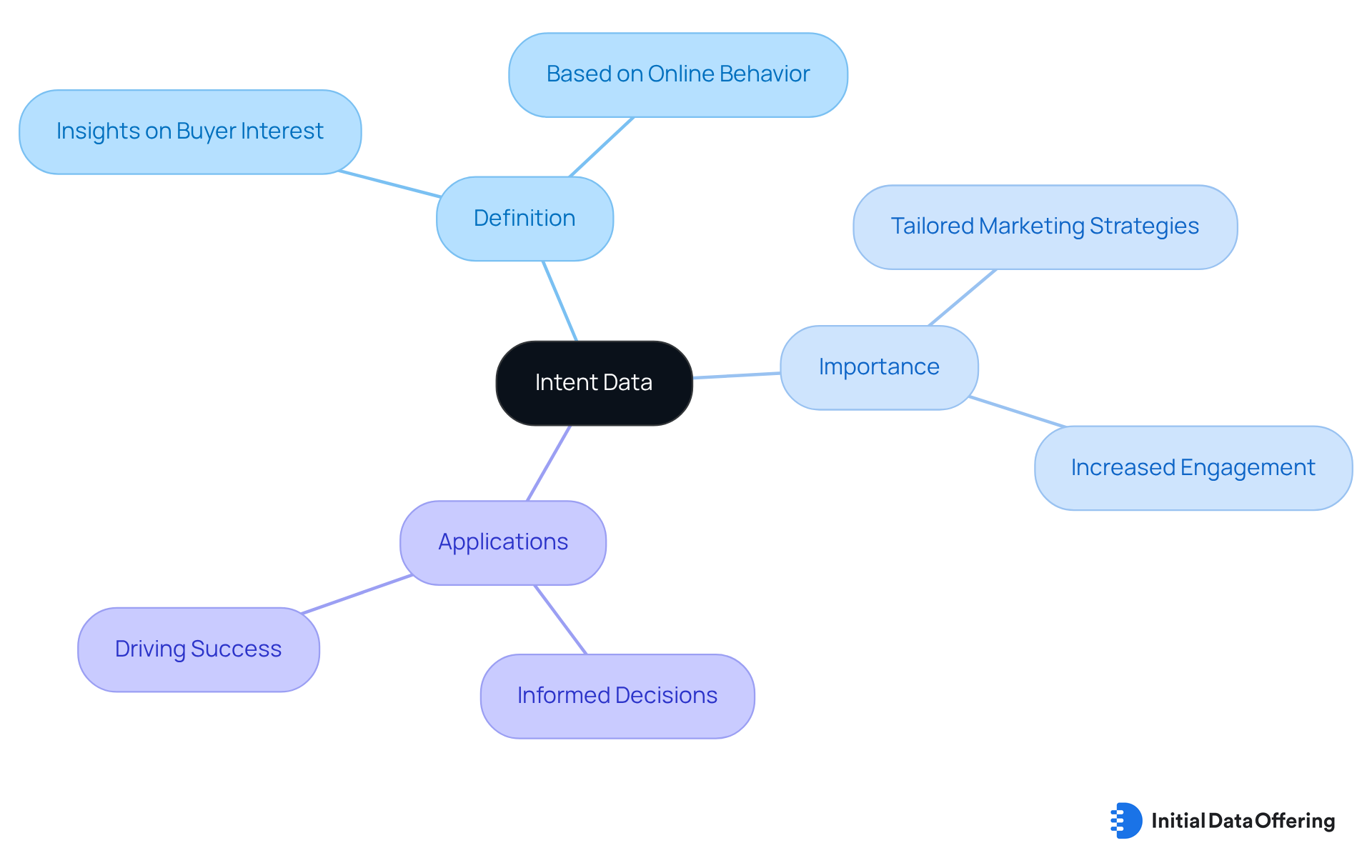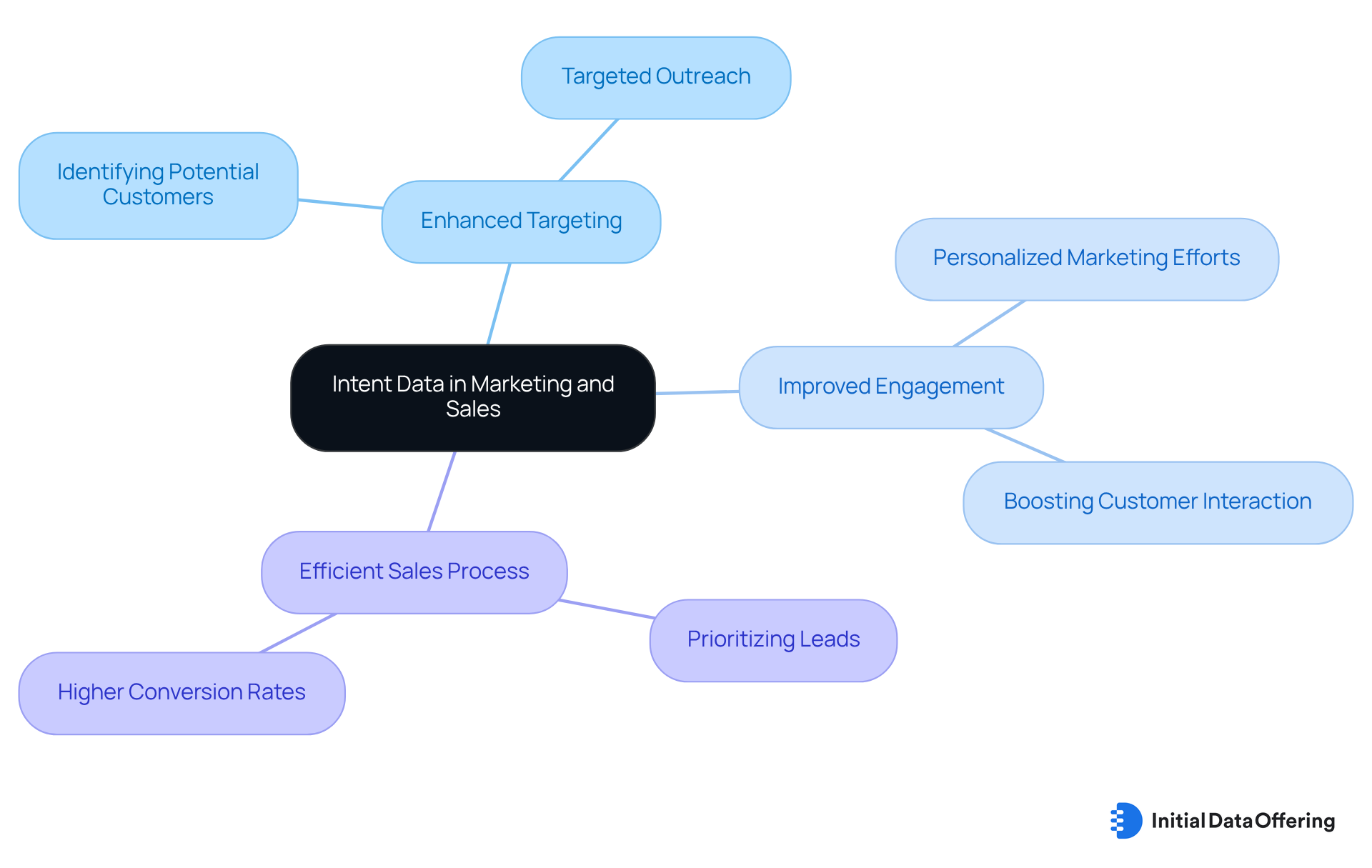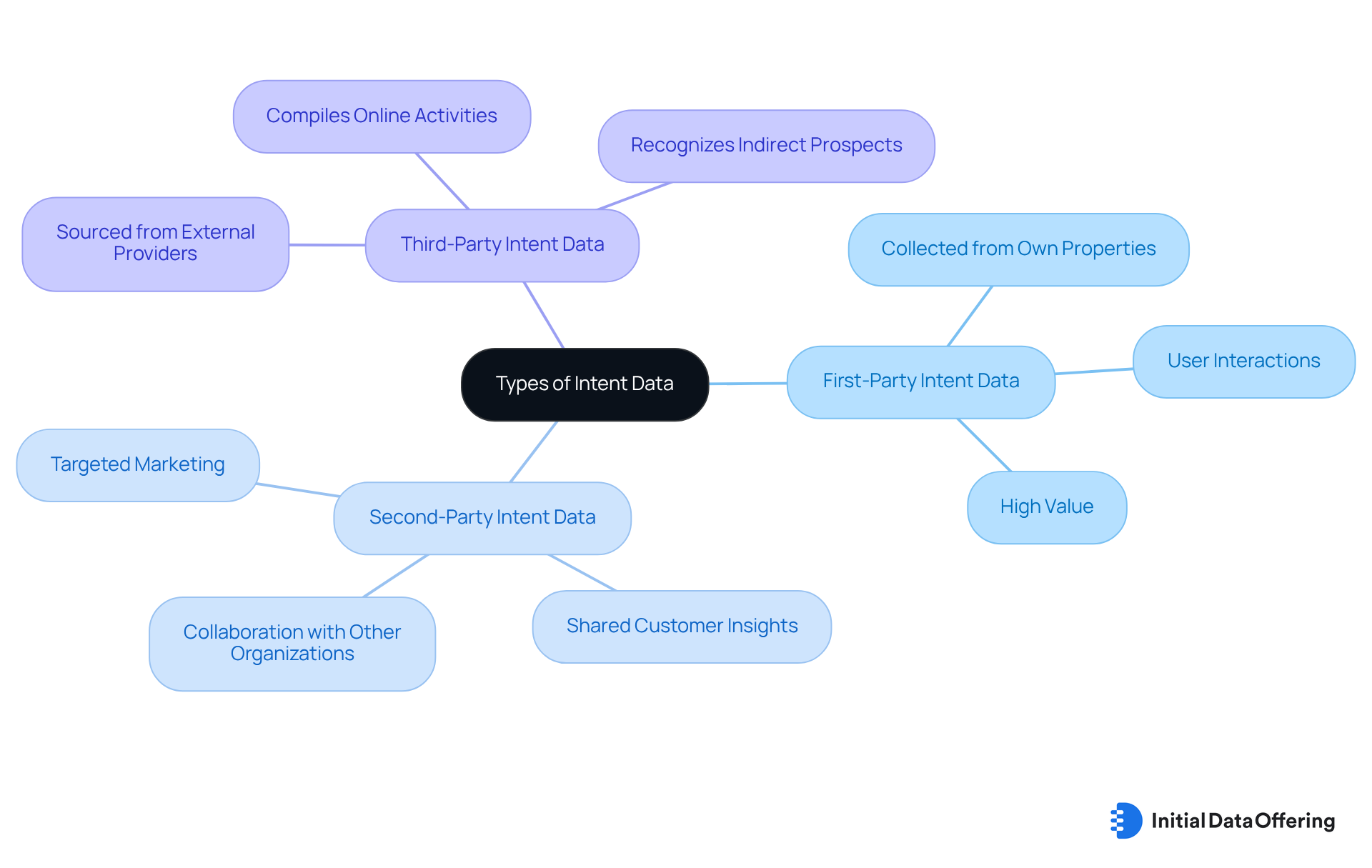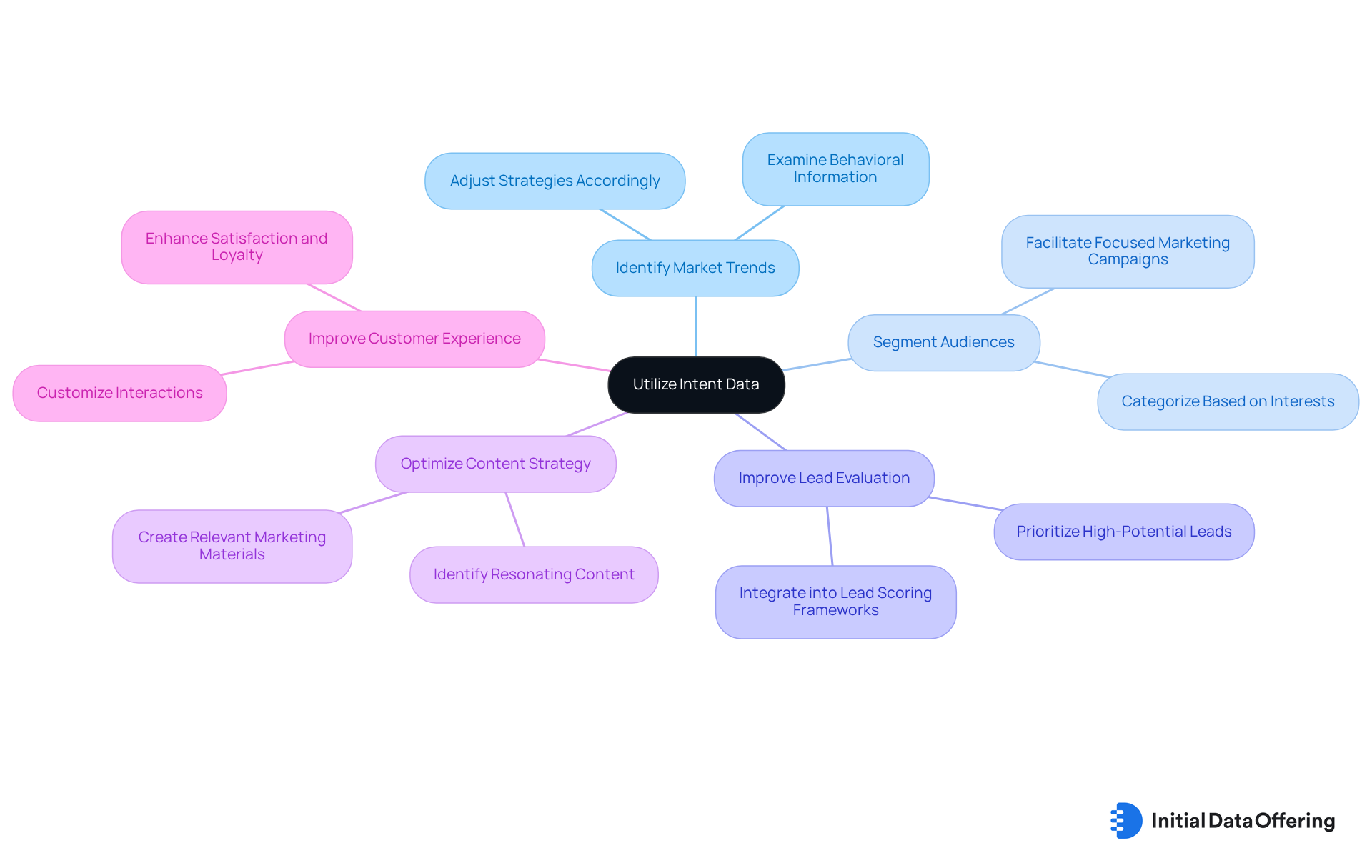What is Intent Data: Definition, Types, and Applications Explained

What is Intent Data: Definition, Types, and Applications Explained
Overview
Intent data encompasses insights derived from the online behaviors of potential buyers, signaling their interest in various products or services. This data is categorized into:
- First-party data
- Second-party data
- Third-party data
Each offering unique insights into consumer behavior. Understanding intent data is crucial for companies, as it enables them to implement targeted marketing strategies. By leveraging this information, businesses can enhance engagement and improve conversion rates, tailoring their outreach based on the specific interests and behaviors of their audience.
How can your organization utilize intent data to refine its marketing efforts? Consider the implications of these insights for your outreach strategies.
Introduction
Understanding the motivations behind consumer behavior is increasingly crucial in today's fast-paced digital landscape. Intent data serves as a valuable resource, offering insights into potential buyers' interests through their online activities, including website visits and social media interactions. By harnessing this data, businesses can refine their marketing strategies, which enhances engagement and boosts conversion rates.
How can organizations effectively leverage this powerful tool to maintain a competitive edge in the market? This question invites exploration of actionable strategies that can be employed.
Define Intent Data: Understanding Its Core Concept
What is intent data refers to insights that indicate a potential buyer's interest in a product or service based on their online behavior. This information is gathered from various digital interactions, such as website visits, content downloads, and social media engagement. Understanding these insights is crucial for companies. By analyzing these signals, companies can tailor their marketing strategies to better align with the needs and interests of their target audience. This not only enhances engagement but also increases the likelihood of conversion.
How can your organization leverage this data to refine its approach? By understanding what is intent data related to what potential clients are exploring and how engaged they are in contemplating a purchase, businesses can make informed decisions that drive success.

Contextualize Intent Data: Importance in Marketing and Sales
In today's competitive environment, purpose information serves as a cornerstone of effective marketing and sales tactics. This dataset allows businesses to identify potential customers who are actively researching their products or services, enabling targeted outreach and personalized marketing efforts. By leveraging intent information, companies can prioritize leads based on their probability of conversion, enhancing the efficiency of their sales funnel. This data-driven approach not only boosts customer engagement but also improves the overall effectiveness of marketing campaigns, ultimately leading to higher conversion rates and increased revenue.
Have you considered how purpose information could transform your marketing strategies? By understanding what is intent data, companies can gain a significant advantage in their outreach efforts. The benefits are clear:
- Enhanced targeting
- Improved engagement
- A more efficient sales process
As you think about your own marketing practices, reflect on how integrating purpose information could elevate your campaigns and drive better results.

Explore Types of Intent Data: First-Party, Second-Party, and Third-Party
What is intent data can be classified into three primary types: first-party, second-party, and third-party.
-
First-Party Intent Data refers to information collected directly from a company's own digital properties, such as its website or mobile app. This data encompasses user interactions, including page views, downloads, and form submissions. Understanding what is intent data highlights the advantage of first-party data, which lies in its high value, as it reflects the behavior of known customers and prospects, providing businesses with actionable insights into their audience's preferences.
-
Second-Party Purpose Information is acquired through collaborations with other organizations that share their primary information. For example, a company might partner with a complementary organization to gain insights into the behaviors of shared customers. This collaboration not only enhances the understanding of customer interactions but also allows for targeted marketing strategies that can benefit both parties.
-
Third-Party Purpose Information is sourced from external providers that compile details from various online activities across multiple websites. The benefit of third-party intent insights lies in their ability to clarify what is intent data related to potential buyers' interests and behaviors. This information enables businesses to recognize prospects who may not have engaged with their brand directly, thus expanding their reach and improving marketing effectiveness.

Utilize Intent Data: Applications for Market Research and Analysis
Understanding what is intent data reveals its numerous applications in market research and analysis. Businesses can leverage what is intent data to identify market trends, segment audiences, improve lead evaluation, optimize content strategy, and enhance their customer experience.
-
Identify Market Trends: By examining behavioral information, companies can reveal emerging trends and shifts in consumer behavior. This insight enables them to adjust their strategies accordingly, ensuring they remain competitive in a dynamic market.
-
Segment Audiences: Intent information allows companies to categorize their audience based on interests and behaviors. This segmentation facilitates focused marketing campaigns that resonate with specific groups, which helps in understanding what is intent data and ultimately increases engagement and conversion rates.
-
Improve Lead Evaluation: By understanding what is intent data, integrating it into lead scoring frameworks allows companies to prioritize prospects demonstrating significant buying motivation. This targeted approach enhances sales productivity, allowing teams to focus on high-potential leads.
-
Optimize Content Strategy: Understanding what is intent data helps companies identify what content resonates with potential buyers, enabling them to create more relevant and engaging marketing materials. This relevance drives higher engagement rates, fostering deeper connections with the audience.
-
Improve Customer Experience: By leveraging insights from what is intent data, businesses can customize their interactions with customers. This personalization enhances satisfaction and loyalty, as customers feel valued and understood.
How can your organization utilize intent information to refine its marketing strategies and improve customer interactions?

Conclusion
Understanding intent data is essential for businesses aiming to enhance their marketing and sales strategies. By analyzing the online behaviors of potential buyers, companies can gain valuable insights that inform their outreach efforts, ultimately leading to improved engagement and higher conversion rates. This data not only helps in identifying prospects but also tailors marketing approaches to meet the specific needs and interests of the target audience.
The article has delved into the definition of intent data, its importance in the marketing landscape, and the various types available, including:
- First-party data
- Second-party data
- Third-party data
Each type offers unique advantages, allowing businesses to refine their strategies and improve lead evaluation, audience segmentation, and content optimization. Moreover, the applications of intent data in market research and customer experience enhancement further highlight its significance in driving business success.
Incorporating intent data into marketing practices is not just a trend; it is a strategic necessity for organizations looking to stay competitive. By leveraging these insights, businesses can make informed decisions that resonate with their audience, ultimately fostering deeper connections and driving growth. Embracing intent data can transform marketing efforts, leading to a more efficient sales process and increased revenue—making it imperative for organizations to explore and implement these insights in their strategies.
Frequently Asked Questions
What is intent data?
Intent data refers to insights that indicate a potential buyer's interest in a product or service based on their online behavior. This information is gathered from various digital interactions, such as website visits, content downloads, and social media engagement.
Why is understanding intent data important for companies?
Understanding intent data is crucial for companies because it allows them to analyze signals of potential buyers' interests. This enables businesses to tailor their marketing strategies to better align with the needs and interests of their target audience, enhancing engagement and increasing the likelihood of conversion.
How can organizations leverage intent data to improve their approach?
Organizations can leverage intent data by understanding what potential clients are exploring and how engaged they are in contemplating a purchase. This insight helps businesses make informed decisions that drive success.